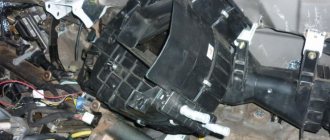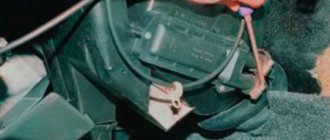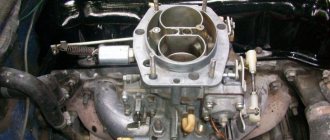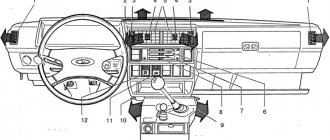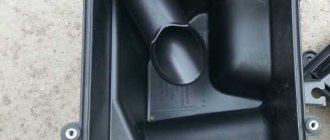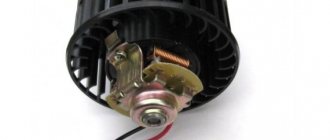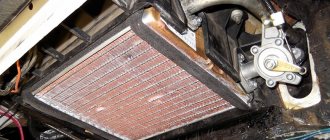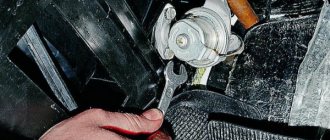Any car enthusiast who has been using one car for 3–5 years has probably noticed a deterioration in the performance of the cabin heater. The traditional repair method is to dismantle the internal heat exchanger and then clean the channels. A common problem arises here: removing the element can be difficult; on some cars you have to disassemble half of the front panel. Therefore, many drivers practice an alternative option - liquid flushing of the heater radiator without removing it from the car.
Flushing the heater radiator without removing it. How to flush the stove radiator without removing it?
With the onset of cold weather, car owners often find that their car's interior heating system is not working efficiently.
Everything seems to be fine, but the air coming from the deflectors is not warm enough. This problem may be an indication that the car’s heater core is clogged and cannot pass the required amount of heated coolant through it. What to do in such a situation: replace the heater or try to repair it? Do not rush to resort to radical measures. If the heat exchanger does not leak, it can be repaired.
In this article we will talk about how to flush the heater radiator without removing it from the car. In addition, we will discuss which products are best suited for this procedure.
Useful tips
After cleaning the heat exchanger, do not be lazy to replace the underwater hoses and install new clamps. After all, it will be very disappointing when, after a few days, the cabin becomes cold again, and the culprit is a small hole in the hose or a loose clamp that leads to air getting into the heater radiator.
Periodically clear the air ducts of leaves and dirt that could reduce the heating efficiency.
Use high-quality coolant to prevent re-contamination of the heater with impurities found in low-quality antifreeze.
Periodically turn on the fan at maximum speed to blow through the outer fins of the radiator.
Replacing the heater radiator on the Lada Kalina is not carried out often, but if a breakdown occurs, there will be no problems, since it is located inside the dashboard. Often, motorists entrust this process to a car service center, but there are also those who want to do it on their own.
In the video, replacing the heater radiator without removing the dashboard:
Why does the radiator clog?
In modern cars, two types of heater radiators are used: copper-brass and aluminum. Each has its own advantages and disadvantages, but they are all susceptible to oxidation and corrosion. Over time, the channels of any radiator lose their capacity due to deposits on the internal walls. This process can also be speeded up by:
- poor quality coolant;
- the use of coolants of different compositions;
- the entry of various debris or active substances, such as oil or gasoline, into the system.
Cleaning the stove on Lada Kalina
In Kalina family cars, antifreeze is changed every 75 thousand kilometers or once every 5 years, whichever comes first. There are questions here, especially such as how to clean the stove on a Lada Kalina hatchback. Over time, deposits appear on the walls of the heating and cooling elements, which impede the passage of fluid and adversely affect the operation of the interior heater. Solve the problem yourself, then take action.
Reasons for poor heater performance
Deposits form on the inner walls of the cooling system elements, which impair the performance of:
- The car engine regularly overheats.
- The heater does not heat the interior when it gets cold.
- The coolant temperature changes abruptly and over a wide range.
This situation cannot last long. The negative impact on almost all components of the machine ultimately leads to serious and expensive repairs. The car heater is no longer able to heat the air in the cabin, and you begin to understand that a clean Kalina stove is simply necessary. Why does this situation happen? The heater radiator stops performing its function:
- The coolant was not changed in a timely manner.
- Low-quality antifreeze was used.
The internal channels of the radiator become clogged with scale and coolant oxidation products, which makes it difficult for the fluid to circulate. This directly affects the process of heating the interior air.
Flushing the stove without removing the radiator
How to flush the heater radiator on Kalina? There are many recommendations posted on the Internet. Just don't expect success if you only change the antifreeze. Every problem can be fixed by spending time and money. Think and decide what to do?
- Remove the heater radiator. Restore the channels through which the fluid passes.
- Buy a new radiator.
- Clean the heater core without removing it.
How to deal with it
The easiest way to get rid of this problem is to flush the stove radiator. Its essence is to drive a special agent through it that can dissolve and wash away all the scale and dirt. There are two cleaning methods: flushing the heater radiator without removing it from the car and with removal. The first method does not involve dismantling the heater. It is enough to simply disconnect it from the cooling system. In the second case, the heat exchanger is dismantled, and the entire procedure can be successfully carried out even in the bathroom. We will focus on the first option, since flushing the stove radiator without removing it is much easier. And considering that in some cars it is not so easy to get to the heater, it is also faster.
How to clean the radiator of a Kalina stove
Heating in a car is not a whim, but one of the functions that ensures a comfortable and safe ride. If frost formed on the glass reduces visibility, then it won’t be long before you end up in an emergency.
As always, in our country, the frosty season comes unexpectedly. If on your next trip, when you press the heating button instead of warm air, cold air blows from the air duct, then the moment has come when you need to clean the heater radiator.
To make this process efficient, it would be useful to understand how the car’s heating system works and what methods and means can be used to clean it.
Heating system
The stove and bypass valve, integrated into the cooling system of the machine, are the main heating elements. The heater radiator is heated due to the high temperature of the engine coolant, which also enters the heat exchanger.
Effective stove cleaning products
Now let’s figure out how to effectively flush the radiator channels. Plain water, you will agree, is unlikely to do. Flushing the stove radiator involves pouring into it agents that can destroy the scale that has formed and deposited on the walls. These means can be:
- special liquids for flushing the cooling system (factory-made);
- household products for cleaning sewer pipes and removing scale (“Mole”, “Komet”, “Tiret”, “Kalgon”, etc.);
- acid solutions (citric, acetic acid);
- alkaline solutions (caustic or soda ash);
- drinks like Fanta or Coca-Cola;
- milk serum.
Preparation for major flushing
To clean the interior heater radiator directly on the car you will need:
- There are two types of detergent – alkaline and acidic;
- standard set of keys, screwdrivers and pliers, funnel;
- a low-power water pump (a household circulation unit for heating and an electric pump from a Gazelle truck are also suitable);
- two hoses 2 meters long with tightening clamps;
- distilled water in an amount of 3 volumes of the cooling system of your car;
- boiler and bucket;
- old nylon tights or gauze folded in three.
Also prepare a container for draining old antifreeze and the required volume of fresh coolant. Often, car enthusiasts wash the heat exchanger of the stove without completely emptying the pipelines and engine jacket, but then all the debris contained in the old antifreeze will again flow into the clean radiator.
It is more convenient to carry out work in a garage equipped with an inspection ditch. To remove deposits without removing the heater from the car, completely drain the antifreeze from the engine in the following order:
- Allow the engine to cool to room temperature and place a container underneath for antifreeze.
- Unscrew the plug on the cylinder block with a wrench, then open the cap of the expansion tank.
- When all the antifreeze has flowed out, screw the plug back into place. If the main radiator has a second drain, repeat the operation.
- Disconnect the pipe at the highest point of the system - on the throttle valve or carburetor heating unit.
On some cars, emptying is prevented by covers that protect the engine compartment from dust from entering from below. There are 2 options to solve the problem: remove the protection or use a long hose attached to the neck after unscrewing the plug.
We recommend: Flushing the engine cooling system - 6 popular methods for quick and high-quality cleaning
Do no harm
Independently flushing the heater radiator without removing it from the car or with removal is not the point; it must take into account the properties of the material from which the element being washed is made. Under no circumstances should you use alkaline solutions to clean aluminum heaters. The metal will instantly begin to oxidize, and the situation will only get worse. The same thing will happen if you pour acid into a copper radiator. Therefore, for aluminum - acidic agents, for copper - alkaline.
Universal remedies include Coca-Cola or Fanta heated to a boil, as well as whey, which has a “mild” destructive effect on scale.
If special liquids for flushing the cooling system have instructions for use, then with household powders, citric acid and soda you need to be extremely careful and know the proportions for preparing the solution.
Pros and cons of each method, possible risks
Flushing the radiator with citric acid:
We recommend: What to do if the engine overheats?
Advantages: low cost, high efficiency.
Disadvantages - if you overdo it with acid, it can lead to quite unpleasant consequences - over time, the acid can corrode the rubber and plastic elements of the system. Citric acid is highly aggressive, so you perform such flushing of the heater radiator at your own risk.
Flushing the radiator with Coca-Cola:
Advantages - low cost, speed, high efficiency (Coca-Cola contains so-called orthophosphoric acid, which effectively fights scale).
The disadvantages of such washing are associated with the gas and sugar content in Coca-Cola. Sugar, which is found in Coca-Cola, can clog the radiator, and the increased state of gases can have a negative effect on the entire system.
Flushing the heater radiator with special means:
Advantages: efficiency, no risks.
Disadvantages - slow action.
How to prepare the solution
Flushing the radiator of the Krotom stove involves preparing a liquid based on it. This will require 10 liters of water and 100 g of the specified powder. The powder is poured into heated water and then mixed thoroughly. After this, it is recommended to strain the resulting liquid (you can use it through an unnecessary woman’s stocking). The same proportions are necessary for the soda solution.
In order for flushing the stove radiator with citric acid to be as effective as possible, you will need at least 300 g per 10 liters of water (30 packs of 10 g each). After dissolution, the resulting liquid must also be filtered.
How to flush the heater radiator without removing it from the car: instructions
First, drain the coolant from the system after warming up the engine. Then we find the inlet and outlet pipes of the heater radiator and, loosening the clamps, disconnect the rubber hoses from them. In their place we attach pre-prepared hoses through which we will pour and drain our cleaning solution.
Before you wash the heater radiator without removing it from the car, you need to remove all the dirt that has not yet settled on the walls. This can be done with ordinary tap water. To do this, pour water (10-20 liters) into one of the hoses, allowing it to flow out from the other end.
Only after this can you begin to clean the heater radiator from scale.
We begin to pour liquid into the first hose through a watering can. Raise the end of the second hose a little, and after the solution flows from it, close it. When the stove is completely filled, close the first hose. Leave the radiator for 2-3 hours so that the scale has time to dissipate. After this, it must be rinsed again with water. If necessary, the procedure can be repeated.
After cleaning the heater radiator, attach communication hoses to it. Pour coolant (preferably new) into the system. Start the engine and check the heater operation. If the situation does not improve, then it is time to replace the radiator.
Work order
To clean the stove with your own hands, you need to find and disconnect 2 pipes leading from the engine compartment into the cabin. Point two: make sure that the heater valve located inside the cabin is open. Next, assemble a washing installation that includes the following elements:
- 2 hoses;
- water pump;
- pantyhose filter.
The purpose of the filter is to prevent dirt and scale particles from getting inside the pump unit, so it must be installed at the end of the hose coming from the heat exchanger. Connect the other pipe to a pump submerged in a bucket of washing solution. If you use a Gazelle pump or a circulation pump, you will have to install a short hose on the suction side to supply water from a bucket.
Before flushing the car heater radiator, connect the hoses of your homemade installation to the heat exchanger pipes. Then proceed according to the instructions:
- Using a boiler, heat the water in a bucket to a temperature of 70–85 °C.
- Turn on the pump by lowering the return hose into a bucket. When a steady flow comes out of it, add a “Mole” type drain cleaner or similar to the hot water (amount - at least 1 liter).
- Rinse the stove for 30 minutes, periodically turning on the boiler. Do not allow the solution to cool or boil.
- After half an hour, stop pumping and remove dirt from the filter. Then swap the suction and return hoses in any convenient way - switch the pipes on the machine or pump unit.
- Start pumping again. Reverse cleaning of the stove radiator is mandatory and lasts 30 minutes.
Important point! If the heat exchanger is made of aluminum alloy, the treatment time with sewage reagent should be reduced to 10–15 minutes. As a rule, such chemicals are made on the basis of alkali and can corrode the radiator honeycombs.
The second stage - washing the stove with clean water - is carried out in a similar way. First, water is supplied in one direction, then in the other, pumping time is 15 minutes. Then replace the filter and proceed to the third stage - acid treatment.
To clean the radiator with citric acid solution, pour 100–150 grams of the reagent into hot water and mix thoroughly. Connect all hoses and start the pump unit again. Removing scale with acid lasts from 30 to 60 minutes, depending on the degree of contamination of the internal surfaces of the heat exchanger. Remember to maintain the temperature of the solution and backwash (also 30–60 minutes).
The last stage is the final rinsing of the stove from scale and acid with distilled water. Run it in both directions for 15 minutes, then stop the pump and blow out the remaining water from the heat exchanger. Assembling and filling the system is done in the following order:
- Reconnect the standard cabin heater pipes.
- Close all drain holes and slowly pour antifreeze through the filler neck.
- When antifreeze flows from the pipe removed from the throttle valve block, put it on the fitting and secure it with a clamp.
- Add coolant to normal level.
Upon completion of assembly, start the engine and warm up to operating temperature 90–95 °C. Check the functionality of the heater by turning on the heating and fan at full power. If the flushing is successful, you will feel the result without measuring with a thermometer.
What you need to know before flushing the heater radiator
Why does the heater radiator clog?
A clogged radiator is one of the most common causes of poor performance of the interior heater. Most often this happens due to poor-quality coolant, mixing two antifreezes of different composition, or the use of water.
All this leads to the formation of plaque on the walls from the inside. Dirt tightly clogs the already thin radiator tubes with swirlers, disrupting circulation, and there can be no talk of any heating.
How to understand that the problem is a clog
Checking whether the heater radiator is really clogged is quite simple. You need to find two thin pipes going into the cabin through the partition of the engine compartment and feel them. If one of them is hot, and the second is barely warm or cold, then this is a blockage.
In some cases, cold air will blow from the heater, even if both pipes are hot. This may indicate the following: everything inside is so clogged that the heated antifreeze enters the radiator tank and, bypassing the honeycombs, immediately leaves it without having time to give off heat.
What to do about it
The standard solution to this problem is to replace the radiator with a new one. This is what the car service will recommend. Here you will have to fork out money, since the cost of work is added to the price of a new radiator, and this is 2-3 times more expensive than the spare part itself. In modern cars, getting to the radiator is very difficult: you need to remove the trim and dashboard, unscrew the air conditioning pipes, and then refuel it.
The second option is washing directly on the machine. In this case, everything is much simpler and you don’t need to remove anything. It is enough to disconnect the pipes going to the heater, connect a pump with hoses instead and run the flushing solution through the radiator.
How effective is flushing the stove radiator?
Cleaning a radiator is much easier, faster and definitely cheaper than replacing, but this procedure also has its downsides. Flushing is not a panacea; the chances of success are approximately 50 to 50. In advanced cases, there is sometimes no effect.
Again, on older cars the radiator can leak only because the deposits that covered the holes in the tubes are washed away. Well, there is always the possibility of dirt from the cooling system getting into the washed stove again.
And yet, before changing the radiator, many car owners prefer to flush it first.
Washing without dismantling
The first and most easily accessible method is to flush the radiator without resorting to any disassembly of the system.
We make a solution of citric acid and distilled water based on the proportion of 100 grams of lemon juice for the entire volume of the cooling system of your car. Drain out the old antifreeze and fill in the solution. Then we drive it for 5-6 days. After this period, drain the liquid, along with which all dissolved dirt and scale will come out. We fill in new antifreeze and enjoy the warmth in the cabin.
The second method requires a little preparation and minor disassembly of the components of the car's heating system.
For this procedure you will need:
- Compressor or water pump.
- A pair of hoses with adapters. One end of which corresponds to the diameter of the hoses coming out of the stove.
- Clamps, container for flushing liquid, fume tape.
- A product that will be used to flush the heat exchanger.
The products that are used to clean the heater radiator are worth covering in more detail. In the selection of such substances, you need to proceed from what material the heat exchanger is made of. If the radiator is aluminum, then it is unacceptable to wash it with alkaline solutions; in this case, products with a certain percentage of acid in their composition are suitable. When flushing a copper-brass heat exchanger, everything should be exactly the opposite.
For the washing procedure, you can use professional products, such as special Mannol liquid, or improvised means.
In choosing available liquids, advice varies; for some, Xylitol or Antiscale has become a panacea for descaling household coffee makers and kettles; others advise using regular Coca-Cola or whey; others praise Krot for cleaning pipes.
But it is better to use a proven method - washing with citric acid, and if the heater is copper - with caustic soda.
How to flush a stove radiator without removing it
Prepare everything you need
Almost everything you need for cleaning can be found in any garage, or purchased in addition at the nearest auto and household store.
- 150–200 g citric acid;
- bucket for 8–10 l;
- container for draining antifreeze;
- hose about 3 m long;
- clamps;
- wires;
- mesh, gauze or nylon;
- water;
- antifreeze for topping up;
- transfer pump;
- boiler or stove;
- spanners;
- screwdrivers.
Understand the essence of the process
The principle of flushing the stove radiator is as follows. The heater is disconnected from the cooling system and a pump with hoses is connected to it. The chemical is dissolved and heated in a separate container, and then the flushing liquid is circulated through the radiator using a pump. This allows you to dissolve and wash away all accumulated dirt.
To prevent garbage from getting inside again, it is collected and removed at the exit using an improvised filter made of gauze or old nylon tights. Then the radiator is washed with clean water and the standard cooling system hoses are installed in place.
Remove the terminals from the battery
When removing the radiator hoses, you may have to disconnect several wiring connectors. Therefore, in order to avoid errors in the control system, it is better to de-energize the on-board network by removing the terminals from the battery. First negative, then positive.
First make sure that the heater is set to maximum heat. If the control is carried out using a tap, then in the closed position it will block the flow of liquid and interfere with flushing.
Drain the coolant
The heater is filled with antifreeze. To prevent liquid from leaking onto the floor when you remove the pipes, you need to drain it into a previously prepared container through the plug on the main radiator.
Since the stove is not the lowest point of the system, you can drain not all the antifreeze, but only part of it. With due care, this can be done directly through the pipes during removal.
Remove the pipes from the heater radiator
Locate and disconnect the two thin pipes that go into the interior. They are located between the engine and the engine compartment bulkhead. Usually they are easy to detect, but if you can’t or are afraid to make a mistake, check the car’s documentation or search on the Internet.
Then simply loosen the clamps and remove the tubes by rotating from side to side. Be prepared for some more coolant to leak out of them.
Connect hoses and pump
Take any hoses of suitable diameter (usually 16 or 18 mm in diameter), put them on the heater pipes and secure with clamps. Connect the free end of one of the hoses to the pump, wrap the other with gauze and lower it into a container for rinsing. Also attach a small piece of hose to the pump to collect liquid.
You should end up with a pattern similar to the one in the photo. As a pump, it is most convenient to use an additional heater pump from the Gazelle, which is sold cheaply in any car store. Other options include a circulation pump from a boiler or a country pump for irrigation.
Prepare and heat the wash
To remove dirt and scale, specialized products, sewage cleaning reagents, caustic soda and regular citric acid are used. The latter is the safest and no less effective.
Take 5–6 liters of water and add 150–200 g of regular citric acid, stir well and heat the solution. You can heat it using a boiler, on an electric stove or from a gas burner. For maximum effect, the water temperature should be at least 75 °C, and preferably close to boiling.
Start the pump
Fill the pump intake hose with the solution, quickly dip the tube into the container and turn on the pump by applying power. After this, the flushing process will begin: the liquid will circulate, draining into the bucket and again flowing from it into the radiator.
If the heater is too clogged, water will flow out of it in a weak trickle at first. Then, as the solution is exposed, the pressure will increase.
A complete flush takes from one to several hours, depending on the condition of the radiator. If the contamination is strong, you may have to change the solution to a fresh one.
The main thing is to change the direction of circulation every 15–20 minutes, swapping the hoses on the pump. This will help remove as much dirt as possible.
When relatively clean water flows out of the radiator in a good flow, the flushing can be considered complete.
Flush the radiator with water
At the end of the process, you need to wash off the remaining citric acid so that it does not later mix with the coolant in the system.
To do this, it is enough to run several liters of distilled water through the radiator. Drain off the remaining solution, rinse the container, then fill it with water and start the pump as in the previous step.
Fill with antifreeze
After all manipulations with a stream of air, remove any remaining water from the radiator and disconnect the flushing hoses. Install the standard ones in their place and secure with clamps.
Check everything again and make sure the plugs are closed. Next, fill in the antifreeze that was drained earlier, and if necessary, add new one so that the level in the expansion tank corresponds to the norm.
Remove air pockets
When removing pipes and flushing, air pockets inevitably form in the cooling system. Over time, they will come out on their own, but because of them, the heater may work intermittently, so it is better to get rid of the air right away.
To do this, you need to drive onto an overpass or a steep hill to raise the car’s radiator as high as possible, and press the gas firmly several times. At this moment, a gurgling sound will be heard inside the heater, which will stop after the plugs come out.
Let's start the washing process
To begin with, by lifting the hood, we find two hoses that provide supply and drainage of fluid to the stove. Then:
- in the radiator fins. Having disconnected these hoses, we extend them, securing the joints with clamps and wrapping them with fum tape for tightness.
- Turning on the compressor, blow out the old antifreeze from the heat exchanger.
- Fill the radiator with diluted citric acid or another selected cleaning liquid, give it time, up to half an hour, to dissolve dirt and deposits. In more advanced cases, this time can be increased to several hours. Some people advise that before pouring, for greater effect, heat the solution to the operating temperature of the antifreeze, and in the case of using Coca-Cola, generally boil it.
- After the selected period of time, drain the liquid into a prepared container.
- This procedure must be repeated until no clear liquid comes out of the drain hose.
- By connecting the pump to one of the hoses, rinse the stove under pressure with clean water.
- By connecting the hoses back and adding antifreeze, you need to eliminate air in the system.
As an additional way to influence internal contaminants, some experts suggest connecting a pump to one of the hoses and lowering it into a bucket that serves as a container for draining liquid, driving the cleaning solution inside the stove in different directions. In order to evenly press all passages in the radiator plates.
